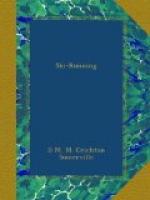Cast-iron toe irons are often used in conjunction with toe bindings in order to avoid the difficulty of the irons being forced open by the boot being pulled through by the spring. These irons have one great fault. They have to be screwed on to the Ski and are very cold under the foot. This may be considered imagination, but I believe it to be true, in which case it may be prejudice.
The toe irons are joined over the toes by a leather toe-strap pulled through and buckled. The irons should be so high that this strap does not press at all on the boot, or restrict the free play of the toes. The whole binding should be so fitted that it is possible to kneel down on one’s Skis.
Foot plates are nailed on the Ski under the foot. These are usually made of linoleum or aluminium. I prefer a thick plain aluminium plate, and find that the snow does not stick to it.
When the Skis have been chosen, sticks have to be provided. A pair of sticks should be used, one being carried in each hand. They are usually made of hazel or bamboo. The latter are light, but tend to split. I always use hazel, which are cheaper and very satisfactory.
Sticks should be so long that they reach to just above the waist and should not be very heavy though strong sticks are necessary for all real touring. They should have padded leather knobs at the tops, as these prevent the stick from slipping out of the hand and being dropped during a run, as well as saving the hand from blisters when the stick is much used in practising lifted stem or jump turns. Wooden knobs are often used but these tend to get coated with ice, which wets the glove and is uncomfortable.
A leather or webbing thong is passed through the stick or nailed under the knob as a loop to hang them up by, but should never be put round the wrist except for uphill work as the wrist might easily be broken in a bad fall, if the stick be attached to it. My great idea is to get rid of my sticks in a fall, as I once impaled my leg on the spike of my stick in a somersault. I was thankful that the spike was a short one and not one of the newfangled aluminium spikes which would have penetrated much further and might easily have done damage to the bone. Only a short spike is necessary—just long enough to go into crusted snow and hold.
The discs round the bottom of sticks should be large, about seven inches in diameter, and they should be loose so that they will lie flat with the Ski when packed. I prefer them put on with a thong which passes through the stick and is crossed backwards and forwards across the disc, allowing of plenty of free play in the disc. By this means, the thong does not cut where it passes through the stick. Discs are often made almost solid and then fixed to the stick with an iron hasp, which is apt to snap or to split the stick.
Sticks hired out with Skis usually have small discs and no knobs, and most beginners will soon wish to possess their own pair, which only cost about twelve francs. A word of advice here. Keep your sticks in your bedroom. Even in the best Ski-ing circles sticks sometimes disappear—and once your own sticks go, you are tempted to take anybody else’s and so the mischief goes on!




